Although the day dawned grey and rainy, we felt optimistic enough to cart ourselves with our pals, the Captains, over to Winchester, ancient capital of England, and currently home to posh schoolboys. We wanted, you see, to show the boy where he would not be studying.
The Winchester City Council's website has several interesting pages, one of which is for a set of city walks. As usual, my intention was to take all three of them, each about a mile or so in length, and covering various aspects of the town. And, as usual, we ended up barely finishing one, and spending much time sitting in a cafe and sipping hot chocolate.
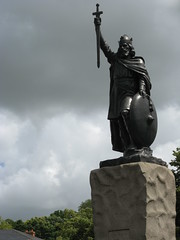 Starting at the Victorian Guildhall, where the Tourist Information Centre distributes free maps, we head left towards the statue of King Alfred - rampant, sword aloft. This is the eastern end of the High Street, the ancient routeway dating from Roman times, and lays claim to be the oldest street in any English city.
Starting at the Victorian Guildhall, where the Tourist Information Centre distributes free maps, we head left towards the statue of King Alfred - rampant, sword aloft. This is the eastern end of the High Street, the ancient routeway dating from Roman times, and lays claim to be the oldest street in any English city.
From there, we enter the grounds of Abbey House, currently the residence of the mayor. There is quite a multitude here, picnicking away and admiring the ducks and swans in a fast moving little channel. Nearby is an abbey founded  by King Alfred's queen. We do not investigate its excavated ruins. Instead, we press on towards St John's House, a medieval almshouse and hospital, and used as a meeting place for the Mayor and the freemen of Winchester in the late Middle Ages.
by King Alfred's queen. We do not investigate its excavated ruins. Instead, we press on towards St John's House, a medieval almshouse and hospital, and used as a meeting place for the Mayor and the freemen of Winchester in the late Middle Ages.
Continuing eastwards, we get to the remains of the Eastgate, where today is the latest incarnation of a long series of mills called the Old Mill. This is a National Trust property, and although we are members of the Trust, we do not take the opportunity to check it out. It's sunny now and we prefer to amble along the lovely Riverside Walk, following the walls of the old city along the fast flowing River Itchen. The river was part of the eastern defences of Winchester, forming a moat. There are supposed to be trout in the stream, none of which attract our attention. But we can well believe that the rapidly moving water powered twelve mills flourishing in the area by the mid-12th century.
We go over (the latest incarnation of bridges dating back to St Swithun in the 9th century) the City Bridge and turn right to start the river walk.
Swithun, a Saxon bishop, became a peerless meteorologist after his death. So taken up were the local yokels with his abilities that they named a day after him, and concocted the following ditty:
St Swithin's day if thou dost rain
For forty days it will remain
St Swithun's day if thou be fair
For forty days 'twill rain na mair
There's a small barricaded remnant of the Roman town walls, first built of stone in the 3rd century AD, and then constantly repaired and embellished over the ages. Near the Wharf Mill is the best-preserved part of the city walls at their full height. Behind them we can hear excited screams from little kids. The Pilgrims' School's Sports Day is in full progress at its playfields, which form part of the grounds of Wolvesey Castle.
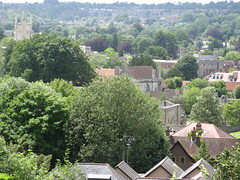 Before continuing along the Riverside Walk, we take a quick detour up to St Giles' Hill to get a view of Winchester from on high. I'm not particularly impressed either by the vista or my photograph. We then hotfoot it back down to the Itchen.
Before continuing along the Riverside Walk, we take a quick detour up to St Giles' Hill to get a view of Winchester from on high. I'm not particularly impressed either by the vista or my photograph. We then hotfoot it back down to the Itchen.
Back before Wolvesey Castle, we are pleasantly surprised to read that where now are the playgrounds of the Pilgrims' School used to be medieval bishops' complex. 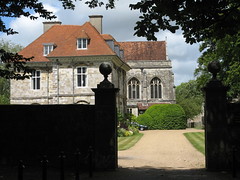 The current bishop's residence dates from 1684, and we grab this quick photograph of one building in the compound before heading for Winchester College. (I guess I ought to do something about the contrast of the foreground, it being a bit too dark, but that's not going to happen today. Or in the near future either.)
The current bishop's residence dates from 1684, and we grab this quick photograph of one building in the compound before heading for Winchester College. (I guess I ought to do something about the contrast of the foreground, it being a bit too dark, but that's not going to happen today. Or in the near future either.)
The entry to Winchester College is only with authorised tour guides, and there's a big sign at the entry by the Porter's Gate which says SORRY - NO TOURS TODAY. An adjoining gate has a sign requesting visitors to use the Porter's Gate, and admonishing members of the college not to forget to lock it behind them.
Winchester College, 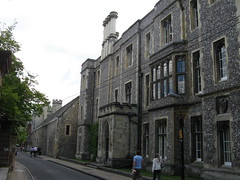 of course, is not a college. It is the oldest continuously running school in England, dating to 1382, founded by William of Wykeham, which explains why its students are called Wykehamoids, and not Winchesterets.
of course, is not a college. It is the oldest continuously running school in England, dating to 1382, founded by William of Wykeham, which explains why its students are called Wykehamoids, and not Winchesterets.
Beyond the school is a private residence with a plaque announcing that Jane Austen had spent her last days there, before giving up her ghost and being buried in the Cathedral. Remembering the dirty  looks I received from the residents of R.L. Stevenson's house in Edinburgh, I make sure that the wife stands before Austen's abode, and take a photo. You will not see that picture here, but here to the right is another taken at an angle.
looks I received from the residents of R.L. Stevenson's house in Edinburgh, I make sure that the wife stands before Austen's abode, and take a photo. You will not see that picture here, but here to the right is another taken at an angle.
At the end of College Street, we have to make a sharp right turn. Why, you ask? Well, because that's what it says in the directions to the walk. I am momentarily prevented from taking an award-winning photograph of the ancient Kingsgate by a gaggle of giggling girls goggling at the gate, and galumphing around grinningly.
The Kingsgate is special for another reason - the cute little church of St Swithun is 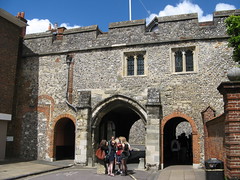 on top of it, above the arches. The first mention of this church is from 1264, although it and the gate was destroyed shortly thereafter by peasants maddened by some recalcitrant monks who, it appears, refused to let them access to the walled city via the gate. The usual town versus gown quarrel, I guess... Several reconstructions and renovations, later, here is what Kingsgate looks like.
on top of it, above the arches. The first mention of this church is from 1264, although it and the gate was destroyed shortly thereafter by peasants maddened by some recalcitrant monks who, it appears, refused to let them access to the walled city via the gate. The usual town versus gown quarrel, I guess... Several reconstructions and renovations, later, here is what Kingsgate looks like.
Through Kingsgate and another right turn brings one (or all) to Prior's Gate, on which the Queen's escutcheon is proudly displayed. "Honey squaw he mauled in pants," goes the motto around a shield held by a rampant lion and a rampant unicorn. Very, umm, Freudian.
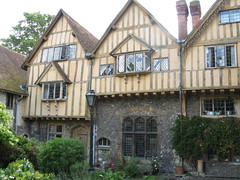 Pass medieval stables on the right, now used as music rooms, and we are at the Pilgrim's School. Two adjacent, early 14th century timber-framed halls are visible, said to have been pilgrims' accommodations at one time. These days, snotty little boys are educated here, the less spotty ones being allowed out into the Cathedral to sing in its choirs.
Pass medieval stables on the right, now used as music rooms, and we are at the Pilgrim's School. Two adjacent, early 14th century timber-framed halls are visible, said to have been pilgrims' accommodations at one time. These days, snotty little boys are educated here, the less spotty ones being allowed out into the Cathedral to sing in its choirs.
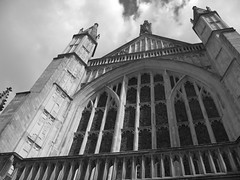 By now, the boy is falling asleep, and the Captains and the wife are looking eagerly around for a cafe. Discouraged by this egregious display of coffee addiction, I take a couple of half-hearted pictures of the environs. The massive Cathedral looms before us and suddenly I'm bored by all the Gothic. So this ends here.
By now, the boy is falling asleep, and the Captains and the wife are looking eagerly around for a cafe. Discouraged by this egregious display of coffee addiction, I take a couple of half-hearted pictures of the environs. The massive Cathedral looms before us and suddenly I'm bored by all the Gothic. So this ends here.
So what did we not see on this trip? Well, Arthur's Round Table was missed. Queen Eleanor's Garden, a reconstruction of a medieval garden, was ignored. We didn't enter either the Cathedral or visit the New Minster. And we gave Hyde Abbey House the old heave-ho. Perhaps next time, what?
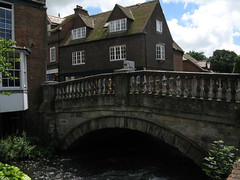
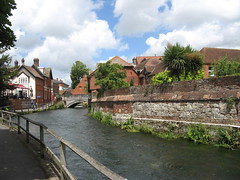

2 comments:
Thanks for stopping by my Winchester post.
Anyway, I love those photos that you've posted. We didn't get to go up to the hill as we were pretty worn out after figuring out our way around.
Wolvesley Castle was quite a bit of disappointment really. Like you, we didn't get to go into the premises itself. But we love the river and spent some time there teasing the ducks. lol
@C.K.: Thanks for stopping by and your kind words. I see you've been up and about recent weekends too. Enjoyed your bit about Southend.
Post a Comment